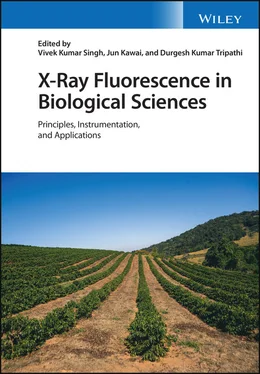X-Ray Fluorescence in Biological Sciences
Здесь есть возможность читать онлайн «X-Ray Fluorescence in Biological Sciences» — ознакомительный отрывок электронной книги совершенно бесплатно, а после прочтения отрывка купить полную версию. В некоторых случаях можно слушать аудио, скачать через торрент в формате fb2 и присутствует краткое содержание. Жанр: unrecognised, на английском языке. Описание произведения, (предисловие) а так же отзывы посетителей доступны на портале библиотеки ЛибКат.
- Название:X-Ray Fluorescence in Biological Sciences
- Автор:
- Жанр:
- Год:неизвестен
- ISBN:нет данных
- Рейтинг книги:5 / 5. Голосов: 1
-
Избранное:Добавить в избранное
- Отзывы:
-
Ваша оценка:
- 100
- 1
- 2
- 3
- 4
- 5
X-Ray Fluorescence in Biological Sciences: краткое содержание, описание и аннотация
Предлагаем к чтению аннотацию, описание, краткое содержание или предисловие (зависит от того, что написал сам автор книги «X-Ray Fluorescence in Biological Sciences»). Если вы не нашли необходимую информацию о книге — напишите в комментариях, мы постараемся отыскать её.
Discover a comprehensive exploration of X-ray fluorescence in chemical biology and the clinical and plant sciences X-Ray Fluorescence in Biological Sciences: Principles, Instrumentation, and Applications
X-Ray Fluorescence in Biological Sciences: Principles, Instrumentation, and Applications
X-Ray Fluorescence in Biological Sciences — читать онлайн ознакомительный отрывок
Ниже представлен текст книги, разбитый по страницам. Система сохранения места последней прочитанной страницы, позволяет с удобством читать онлайн бесплатно книгу «X-Ray Fluorescence in Biological Sciences», без необходимости каждый раз заново искать на чём Вы остановились. Поставьте закладку, и сможете в любой момент перейти на страницу, на которой закончили чтение.
Интервал:
Закладка:
Table 3.5shows the ranges of element concentrations, average concentrations, and standard deviations from the average (n = 3) obtained from the analysis of 19 samples of tea leaves of Krasnodar tea.
The Student's test was used to evaluate the two quantitative data sets obtained by TXRF and wavelength dispersive X‐ray fluorescence (WDXRF). Good results convergence was obtained for Cl, K, Ca, Mn, Fe, Cu, Zn, Rb, Sr, and Ba. However, the concentrations of P, S, Ni observed in the data had relatively low convergence (74% on average), which is explained by the possible influence of unconsidered factors, which demands further research. Advantages of TXRF over WDXRF include using fewer CRM to quantify data, reducing detection limits for most elements by about an order of magnitude, and not having matrix effects when emitters meet the thin layer criterion.
3.7 Interelement Effects and Procedures of their Accounting
The present level of development of the theory of X‐ray fluorescence excitation allows researchers to accurately calculate fluorescence intensities for homogeneous samples. In this case software enables us to take into account different matrix effects: the effect of enhancement of element atoms, primary and fluorescent radiation scattered from the sample atoms, enhancement by sample Auger‐ and photoelectrons, cascade transitions, etc. [7790–92].
Table 3.5 Range, mean ( C mean) and standard deviation ( S ) of elements' concentrations in tea leaves for the set of Krasnodar tea samples.
| Element | Concentrations in tea leaves, mg/kg | |
|---|---|---|
| Range | Mean and standard deviation | |
| P | 2497–5083 | 3629 ± 616 |
| S | 3057–4822 | 3830 ± 496 |
| K | 13 202–29 710 | 19 984 ± 4385 |
| Ca | 4173–6922 | 5371 ± 787 |
| Mn | 480–2007 | 1222 ± 451 |
| Fe | 96.1–327 | 177 ± 71 |
| Ni | 2.96–12.6 | 7.90 ± 2.45 |
| Cu | 10.2–33.8 | 19.8 ± 6.28 |
| Zn a | 20–40.7 | 33 ± 7.0 |
| Br b | 1.8–6.23 | 3.24 ± 1.24 |
| Rb | 15.2–166 | 67.1 ± 46.6 |
| Sr | 10.6–51.3 | 20.8 ± 9.58 |
| Ba | 8.89–63.2 | 40.5 ± 14.2 |
| Pb | n/d c–1.23 | 0.305 ± 0.316 |
a‐ In sample M6 Zn with concentration of 1223 mg/l is found, it was not considered at C meanestimation.
b‐ Analysis of suspension
c‐ n/d – it is not determined.
In the 1970s the contribution the secondary electrons, scattered and fluorescent radiation, and the influence of the divergence of the primary beam to the intensities of X‐ray fluorescence were estimated by Irkutsk X‐ray physicists [77, 93]. The influence of inaccuracies in the fundamental parameters, inaccuracies in the description of the distribution of the energy of the primary radiation, etc. were evaluated [42, 75, 76, 94].
We must list some Russian researchers who have contributed to the solution to these problems: N.F. Losev, G.V. Pavlinsky, V.P. Afonin, A.G. Revenko, Yu.I. Velichko, B.I. Kitov, V.Ya. Borkhodoev, A.L. Finkel'shtein, et al. At that time, many investigations were conducted by our foreign colleagues. First, one has to mention J. Sherman, H. Ebel, T. Shiraiwa, N. Fujino, L.S. Birks, M. Mantler, J. Criss, J. Gilfrich, B. Vrebos, K. Nielson, and others. These researches are being successfully continued by B. Kanngiesser, B. Beckhoff, W. Malzer, R. Sitko, and others.
The possibility of the application of theoretical intensities was used in the Analytical Center at Institute of the Earth's Crust SB RAS (Irkutsk) to select specific CRMs suitable for calibration to convert measured intensities of analytical lines into concentrations of analyzed elements for different types of geological samples [3495–99].
The estimates of inter‐elemental effects on the intensity of analytical lines for tea, coffee, and some plants which were used in calibration and validation of XRF were presented by Revenko and Sharykina [15]. Table 3.6show the estimates of the change of the relative specific intensities (I rel) calculated by the authors of this chapter for the analytical lines of some elements. Variations of the intensity of coherently and non‐coherently scattered radiation of the Rh Kα‐line anode of the X‐ray tube are also given. The minimum and maximum I relvalues are set in bold. Calculations of the intensities were carried out using the program developed by Finkelstein and Afonin [100]. The program algorithm includes the contributions of secondary and tertiary excitation effects as well as the contribution of the radiation scattered by the sample. CRM of the gabbro SGD‐2 [101], diluted in the ratio of 19 : 1 water was taken to calculate the relative intensities of all analytical lines as the reference sample. The calculated intensities were normalized to the ratio of the concentrations of C samp/C ref, where, C sampand C refare the concentrations of the element in the CRM or the sample plants and in a reference sample, respectively. For all analytical lines, I relfor a reference sample is 1.000.
Table 3.6 The relative specific intensities of I relfor the analytical lines of some of elements, as well as the intensities of coherently (coh) and incoherently (nc) scattered radiation of the Rh Kα line for a group of samples of plant materials. The minimum and maximum Irel values in Table 3.6are shown in bold.
| Sample | Si Kα | K Kα | Ca Kα | Ti Kα | Fe Kα | Ni Kα | Sr Kα | Rh Kα coh | Rh Kα nc |
|---|---|---|---|---|---|---|---|---|---|
| Ground coffee | 1.015 | 0.955 | 0.740 | 0.649 | 0.687 | 0.720 | 0.705 | 0.734 | 0.812 |
| Instant coffee | 1.010 | 0.865 | 0.733 | 0.561 | 0.542 | 0.566 | 0.545 | 0.579 | 0.703 |
| Tea1 | 1.034 | 0.985 | 0.908 | 0.880 | 0.885 | 0.930 | 0.932 | 0.942 | 0.964 |
| Tea2 | 0.996 | 0.964 | 0.829 | 0.818 | 0.784 | 0.759 | 0.736 | 0.761 | 0.822 |
| GBW 08505 | 1.041 | 1.106 | 0.971 | 0.973 | 0.995 | 1.075 | 1.088 | 1.088 | 1.054 |
| Cinnamon | 1.008 | 1.005 | 0.911 | 0.750 | 0.726 | 0.725 | 0.701 | 0.730 | 0.796 |
| Turmeric | 1.016 | 0.919 | 0.775 | 0.744 | 0.735 | 0.774 | 0.764 | 0.789 | 0.855 |
| Black pepper | 1.013 | 0.894 | 0.724 | 0.639 | 0.621 | 0.644 | 0.624 | 0.656 | 0.755 |
| Pepper paprika | 1.015 | 0.769 | 0.561 | 0.519 | 0.500 | 0.519 | 0.498 | 0.531 | 0.675 |
| Rice flour | 1.018 | 1.036 | 1.041 | 0.970 | 1.114 | 1.192 | 1.231 | 1.200 | 1.147 |
| Wheat flour | 1.018 | 1.009 | 0.999 | 1.023 | 1.050 | 1.116 | 1.142 | 1.125 | 1.094 |
| Rye flour | 1.018 | 0.995 | 0.943 | 0.970 | 0.964 | 1.164 | 1.037 | 1.035 | 1.030 |
| Linen flour | 1.006 | 0.851 | 0.748 | 0.701 | 0.691 | 0.721 | 0.708 | 0.737 | 0.823 |
| Oatmeal | 1.017 | 0.975 | 0.925 | 0.928 | 0.942 | 0.999 | 1.011 | 1.012 | 1.016 |
| Haricot | 1.015 | 0.916 | 0.763 | 0.731 | 0.724 | 0.761 | 0.749 | 0.776 | 0.847 |
| SRM1573a | 0.992 | 1.032 | 0.780 | 0.576 | 0.570 | 0.624 | 0.666 | 0.617 | 0.730 |
| SRM1515 | 1.037 | 1.118 | 0.917 | 0.886 | 0.913 | 1.016 | 1.123 | 0.985 | 0.983 |
| SBMT 02 | 1.034 | 1.012 | 0.847 | 0.819 | 0.841 | 0.934 | 1.030 | 0.913 | 0.942 |
| LB1 | 1.011 | 1.028 | 0.984 | 0.923 | 0.929 | 0.972 | 0.979 | 0.984 | 0.989 |
| Tr1 | 1.015 | 1.021 | 0.949 | 0.938 | 0.953 | 1.004 | 1.019 | 1.019 | 1.016 |
The CRM list includes: GBW 08505 – Tea leaves, SRM1573a – Tomato leaves, SRM1515 – Apple leaves, SBMT 02 – Herb mix, LB1 is CRM 8923‐2007 – Birch leaves, and Tr1 is CRM 8922‐2007 – Meadow herbal mix. The sample plants list includes ground coffee, instant coffee, two samples of tea leaves, cinnamon, turmeric, black pepper, pepper paprika, oatmeal, haricot, rice flour, wheat flour, rye and linen flour. The content ranges of some elements in CRMs and the sample plants are, %: Na (0.0024–1.96); Mg (0.095–1.2); Al (0.002–1.0); Si (0.009–1.1); P (0.083–0.6); S (0.097–0.96); Cl (0.023–1.92); K (0.37–4.44); Ca (0.054–5.05); Mn (0.0007–0.12); Fe (0.0056–0.26); Sr (0.0002–0.0345). The element content ranges in real plants are, %: Na (0.003–0.31); Mg (0.08–1.63); Al (0.004–2.37); Si (0.009–15.44); P (0.087–0.45); S (0.06–0.96); Cl (0.01–1.20); K (0.71–5.37); Ca (0.31–21.40); Mn (0.0020–1.2); Fe (0.0083–1.40); Sr (0.0025–0.091). For most elements, the concentration ranges are wider for real plants than comparable CRMs.
Читать дальшеИнтервал:
Закладка:
Похожие книги на «X-Ray Fluorescence in Biological Sciences»
Представляем Вашему вниманию похожие книги на «X-Ray Fluorescence in Biological Sciences» списком для выбора. Мы отобрали схожую по названию и смыслу литературу в надежде предоставить читателям больше вариантов отыскать новые, интересные, ещё непрочитанные произведения.
Обсуждение, отзывы о книге «X-Ray Fluorescence in Biological Sciences» и просто собственные мнения читателей. Оставьте ваши комментарии, напишите, что Вы думаете о произведении, его смысле или главных героях. Укажите что конкретно понравилось, а что нет, и почему Вы так считаете.











